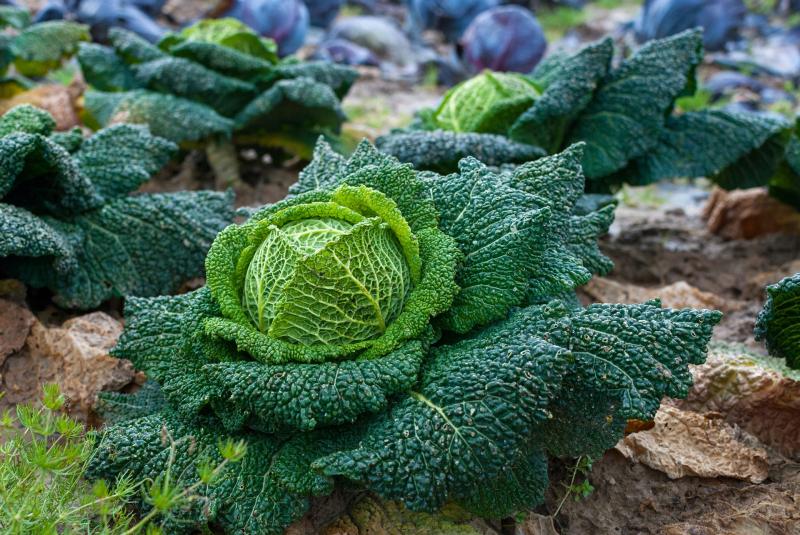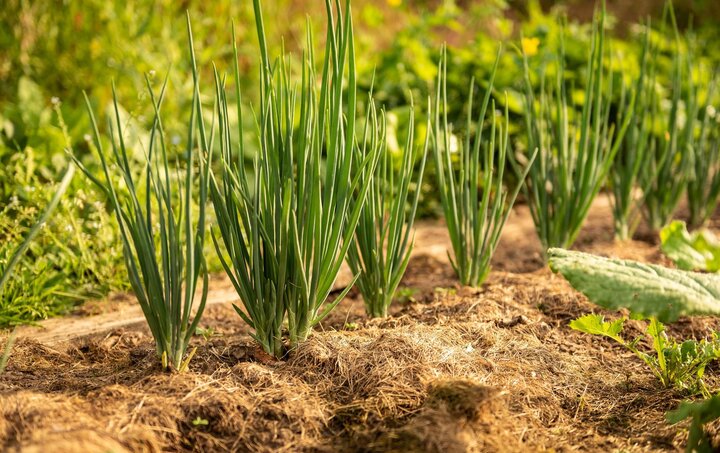Sarah Browning, Extension Educator

Savoy cabbage ready for harvest. Image from Pixabay.
Home vegetable or flower gardeners are often unhappy with their soil quality. They routinely incorporate organic matter in the soil each fall, but don't see much change in their soil texture. Why aren’t they developing beautiful crumbly dark brown soil that’s easy to plant and great for vegetable root crops?
Routinely tilling garden soil each fall and spring could be the culprit.
Microbes, Humus and Soil Aggregation
USDA Natural Resource Conservation Service encourages building soil health and protecting soil organisms, through
- keeping the soil covered as much as possible
- disturbing soil as little as possible
- keeping plants growing throughout the year to feed soil, and
- diversifying plant material through crop rotation.
Organic matter comes from the decomposition of plant and animal remains and is a food source for these soil organisms, releasing nutrients as it breaks down into humus. The amount of organic matter in soil varies depending on the kinds of crops grown, whether plant residue is removed or incorporated into the soil, the frequency of tillage, and the wetness or drainage of the soil. Humus is decomposed organic matter that has reached a stable stage and will not decompose any further without a change in temperature, pressure or heat. Humus is very important to healthy soil because it increases populations of soil organisms by improving water-holding capacity, increasing water percolation, and reducing soil erosion and nutrient leaching. Through their normal life processes, soil fungi create substances that act as glue, binding together particles of organic matter, humus, silt, clay and/or sand. These tiny clumps of particles are called soil aggregates. Benefits of No-Till Gardening Soil aggregates are important because their variation in size creates large and small pore spaces in the soil, which are used as pathways for water, oxygen and plant roots. Soils with good aggregate formation tend to be more loose and crumbly. Tilling physically breaks down soil aggregates, reducing the benefits they provide to soil structure.
Reducing or eliminating tilling in your garden provides the following benefits.
- Slower decomposition of organic matter, resulting in increased organic matter levels
- Increased soil organism populations and activity
- Retention of current soil aggregates and increased formation of new soil aggregates
- Improved water percolation into soil and water drainage
- Improved soil aeration
- Improved crop root development
- Increased resistance to wind and water soil erosion

- mulched 8 to 10-inches deep with organic materials,
- planted with grass or another ground cover, or
- covered with newspaper/cardboard and mulch. When using newspaper or cardboard, start with several layers and top them with 2 to 4-inches of leaves, grass clippings, etc. This holds the paper and cardboard in place as they degrade.
When you’re ready to plant in spring, simply push aside the mulch layer where you want to place your seeds or transplants. Use a hoe to create a planting furrow or hand-dig holes for individual transplants. Once the plants are up and growing, pull the mulch back in place or reapply fresh mulch around the base of the plants. This will prevent rain splash of soil and plant pathogens onto the lower leaves - which is the most common method of disease introduction - and conserve soil moisture.
At the end of the growing season, dead vegetation can be incorporated into the mulch layer as long as plants were not severely insect or disease infested. Or, if you prefer, compost it first then spread the compost over your garden. Replenish the mulch layer over planting beds as needed during spring and summer; maintain an 8- to 10-inch layer in fall and winter. Next year, consider adding a fall cover crop seeding into your no-till system to add more organic matter and more quickly break up heavy soil. For more information on cover crops, check out Cover Crops and Green Manures in Home Gardens, University of Minnesota Extension.
Gain Mastering Over Weeds
One final benefit of no-till gardening - reducing weed problems. Tilling brings fresh weed seed to the soil surface each year, so combining good weed management with no-till practices will eventually reduce the amount of weed seed in the upper few inches of soil. Plus, the thick mulch layers used to create your beds reduces light penetration into the soil surface and further reduces weed seed germination. Image
- Green onions mulched with grass clippings to control weeds and improve soil quality. Image from Pixabay.
Search Our Archive
Associated Video
Digging Deeper Soil Amendments
Nebraska Extension Turfgrass Specialist Roch Gaussoin talks about healthy soil and amending poor soil. May 7, 2021